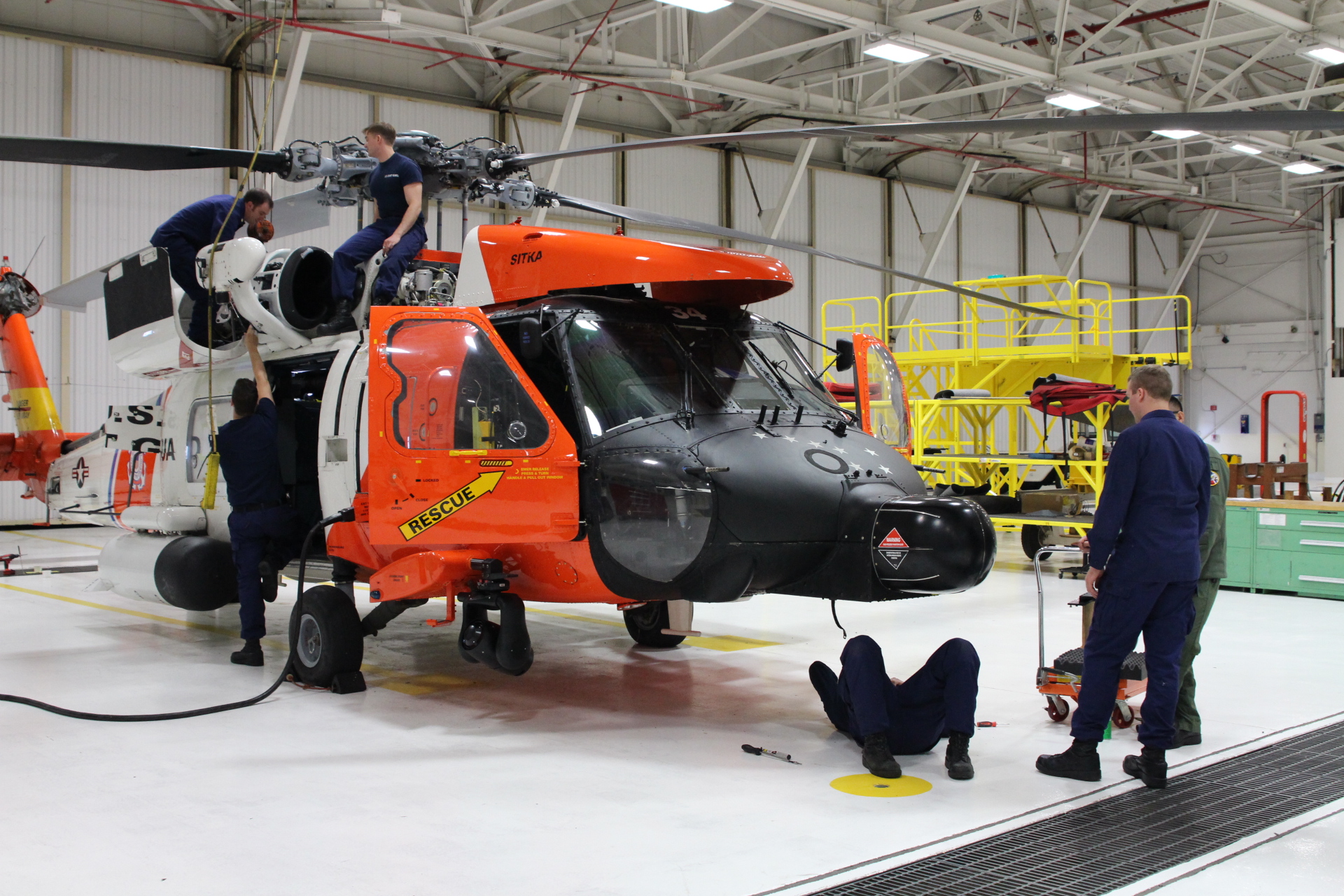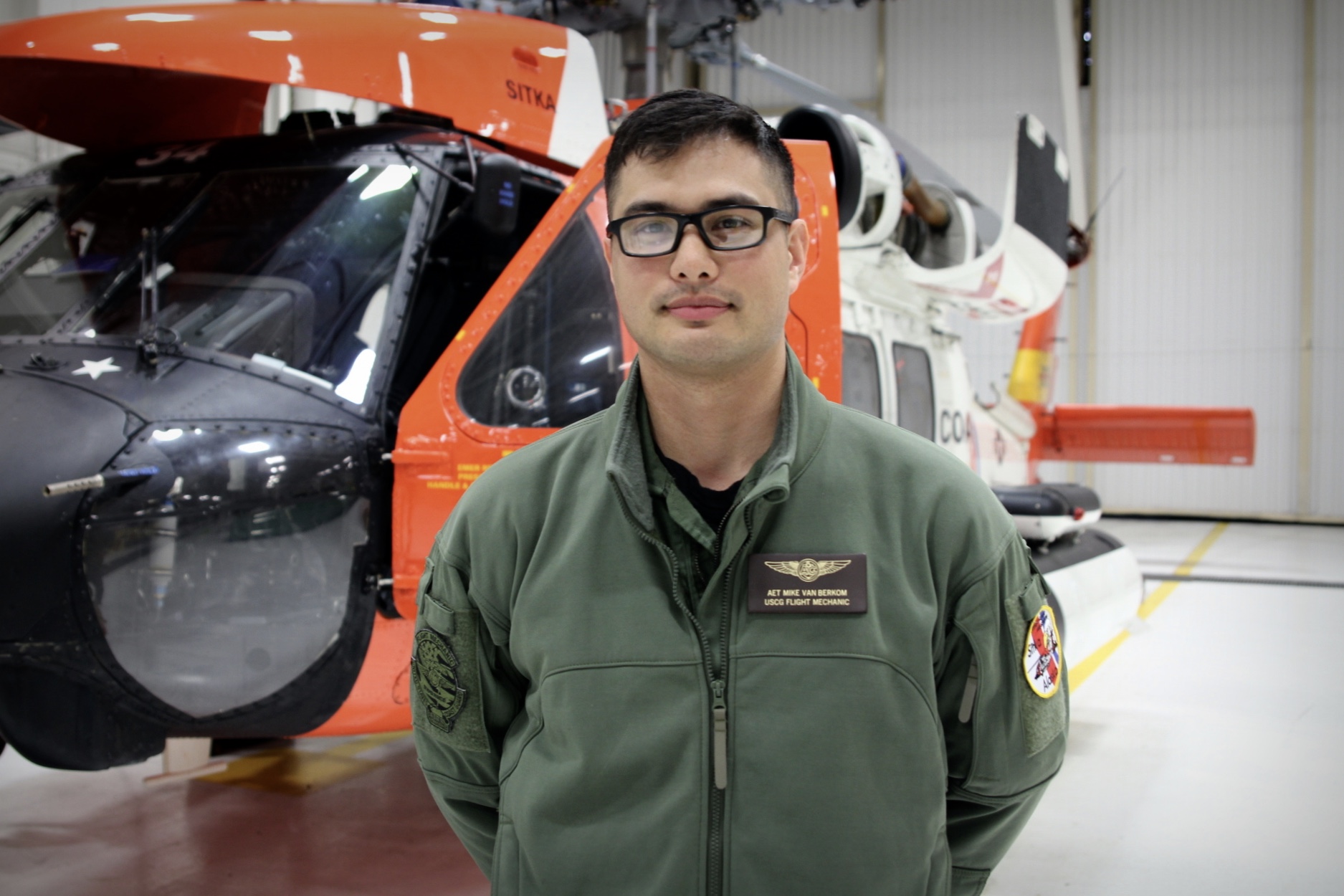
It’s been 40 years since the hangar doors opened at Air Station Sitka. Since 1977 Coast Guard helicopters have been flying all over Southeast Alaska for rescue missions and medevacs.
Air Station Sitka is just across the bridge from downtown. After you pass the airport on your left there’s a chain link gate and a little booth.
Lt. Ray Jamros is a helicopter pilot, who pulls double-duty as the Air Station’s communications and external affairs officer. Up some stairs, the walls are lined with 8 by 11 inch frames.
“The whole hallway out here has plaques from different cases and awards the Air Station has received,” Jamros explained.
The original Air Station in Southeast was on Annette Island, 25 miles south of Ketchikan. But Sitka was more centrally located, so the Coast Guard decided to relocate the the base in 1977.
Walking up to the operations center, Jamros points out the gift shop.

“We sell sweatshirts, t-shirts, patches, hats– just some Air Station memorabilia,” Jamros said.
The Coast Guard crew at Air Station- they’re seen as heroes in Sitka. But the operations center– it’s not what you’d expect. It looks like the inside of your average office building, but with a few more maps.
One of those maps shows just how much area Air Station Sitka covers.
“We cover all of Southeast Alaska,” Jamros explained. “That includes everything from the Canadian border down south of Ketchikan by Prince Rupert all the way up to Yakutat in the north.”
That’s 12,000 miles of coastline
“So it’s a huge area,” Jamros said.
But many of the rescues happen pretty close to base. A video from a rescue back in April shows one of the most recent rescues.
A 70-year-old man slipped and fell while out walking around the old WWII base. It’s less than a mile from the Air Station. The man was huddled on large, wet rocks. It was pouring rain. An Air Station crewmember in a bright orange dry suit helped the man into a wire basket and is then hoisted up safely into the helicopter.
That same day another Jayhawk was deployed on a rescue mission. This time it flew about 10 miles north of town, where a boat was taking on water.
Multiple missions are not unheard of here, which is why Air Station Sitka houses three Jayhawk helicopters.
Two of them are usually on standby, ready to fly at any moment, and one is here, in the hangar. Like your car, Lt. Ray Jamros said, the helicopters need regular tune ups.
“You can see right now that the tail is totally off the helicopter,” Jamros explained. “Sometimes all the blades are off– it’ll look like there’s nothing on it. They tear everything apart, inspect all the parts and pieces and then put it back together.”

And doing some of that meticulous work is Michael Van Berkom.
Van Berkom is an avionics electrician. Every couple hundred hours he and a team of Air Station technicians strip the Jayhawks to the bone.
“Everything from the most advanced automatic flight control system… to simple things like light bulbs and switches– we test it all to make sure it’s good to go,” Van Berkom said.
The helicopters average 100 missions a year, and the pilots here are always prepared to go out.
“[The] Air Station’s basic mission is readiness for search and rescue,” Chip Lewin, Air Station Sitka’s Commanding Officer, said.
“We will always be saving lives,” Lewin said. “We will always be defending our homeland. We will always be protecting the environment and protecting our maritime trade regardless of what’s going on in the rest of the world.”
Like a lot of the other officers here, Lewin joined the Coast Guard to save lives. And he’s come to the right place. In its 40 years of operating, Air Station Sitka has saved over 2,000 of them.
Emily Russell is the voice of Alaska morning news as Alaska Public Media’s Morning News Host and Producer.
Originally from the Adirondacks in upstate New York, Emily moved to Alaska in 2012. She skied her way through three winters in Fairbanks, earning her Master’s degree in Northern Studies from UAF.
Emily’s career in radio started in Nome in 2015, reporting for KNOM on everything from subsistence whale harvests to housing shortages in Native villages. She then worked for KCAW in Sitka, finally seeing what all the fuss with Southeast, Alaska was all about.
Back on the road system, Emily is looking forward to driving her Subaru around the region to hike, hunt, fish and pick as many berries as possible. When she’s not talking into the mic in the morning, Emily can be found reporting from the peaks above Anchorage to the rivers around Southcentral.




